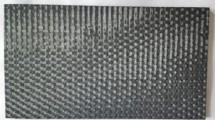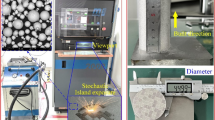Abstract
Shear thickening polishing (STP), an emerging polishing method, is used to polish the cemented carbide insert with complex shape in this study. The principle and performance of STP were introduced. Four parameters having significant influence on the STP process, including polishing speed, abrasive concentration, abrasive size, and inclination angle of fixture, were experimentally investigated. The influence of the four parameters on the surface quality of cemented carbide insert was analyzed by orthogonal experiment method, and the optimal processing parameter combination for the STP of cemented carbide insert was determined. Although the influence degree of the processing parameter on the left cutting edge PA, the top cutting edge PB, the root cutting edge PD, and the right cutting edge PK was different, the optimal processing parameter combination for each position was the same: polishing speed of 90 rpm, abrasive concentration of 9 wt%, abrasive size of #8000, and inclination angle of 4°. Under the optimal processing parameter combination, the surface roughness of cemented carbide insert at the left cutting edge PA was reduced from 121.8 to 7.1 nm after 15 min polishing. The scanning electron microscopy (SEM) and the white light interferometer confirmed the effectiveness of the STP process in the polishing of cemented carbide insert. The experimental results show that STP was a promising and feasible processing method in the polishing of cemented carbide insert with complex shape.
Similar content being viewed by others
References
Fulemova J, Janda Z (2014) Influence of the cutting edge radius and the cutting edge preparation on tool life and cutting forces at inserts with wiper geometry. Procedia Eng 69(1):565–573. https://doi.org/10.1016/j.proeng.2014.03.027
Biermann D, Aßmuth R, Schumann S, Rieger M, Kuhlenkötter B (2016) Wet abrasive jet machining to prepare and design the cutting edge micro shape. Procedia CIRP 45:195–198. https://doi.org/10.1016/j.procir.2016.02.071
Priarone PC, Rizzuti S, Settineri L, Vergnano G (2012) Effects of cutting angle, edge preparation, and nano-structured coating on milling performance of a gamma titanium aluminide. J Mater Process Technol 212(12):2619–2628. https://doi.org/10.1016/j.jmatprotec.2012.07.021
Bouzakis KD, Charalampous P, Kotsanis T, Skordaris G, Bouzakis E, Denkena B, Breidenstein B, Aurich JC, Zimmermann M, Herrmann T, Saoubi RM (2017) Effect of HM substrates’ cutting edge roundness manufactured by laser machining and micro-blasting on the coated tools’ cutting performance. CIRP J Manuf Sci Technol 18:188–197. https://doi.org/10.1016/j.cirpj.2017.02.003
Zhang S, Zou B, Liu YN, Wang YS, Huang CZ, Liu ZQ (2018) Edge passivation and quality of carbide cutting inserts treated by wet micro-abrasive blasting. Int J Adv Manuf Technol 96(5–8):2307–2318. https://doi.org/10.1007/s00170-018-1705-7
Ventura CEH, Köhler J, Denkena B (2013) Cutting edge preparation of PCBN inserts by means of grinding and its application in hard turning. CIRP J Manuf Sci Technol 6(4):246–253. https://doi.org/10.1016/j.cirpj.2013.07.005
Aurich JC, Effgen C, Kirsch B (2016) Cutting edge preparation with elastic bonded superabrasive grinding wheels. CIRP Ann 65(1):329–332. https://doi.org/10.1016/j.cirp.2016.04.093
Bouzakis KD, Gerardis S, Skordaris G, Katirtzoglou G, Makrimallakis S, Klocke F, Bouzakis E (2009) Effect of dry micro-blasting on PVD-film properties, cutting edge geometry and tool life in milling. Surf Coat Technol 204(6–7):1081–1086. https://doi.org/10.1016/j.surfcoat.2009.07.018
Karpuschewski B, Schmidt K, Beňo J, Maňková I, Prilukova J (2014) Measuring procedures of cutting edge preparation when hard turning with coated ceramics tool inserts. Measurement 55:627–640. https://doi.org/10.1016/j.measurement.2014.06.008
Hu ZH, Qin C, Chen ZJ, Yang ZZ, Fang T, Mao MJ (2018) Experimental study of chemical mechanical polishing of the final surfaces of cemented carbide inserts for effective cutting austenitic stainless steel. Int J Adv Manuf Technol 95(9–12):4129–4140. https://doi.org/10.1007/s00170-017-1493-5
Fu YZ, Wang XP, Gao H, Wei HB, Li SC (2016) Blade surface uniformity of blisk finished by abrasive flow machining. Int J Adv Manuf Technol 84(5–8):1725–1735. https://doi.org/10.1007/s00170-015-8270-0
Cheung FY, Zhou ZF, Geddam A, Li KY (2008) Cutting edge preparation using magnetic polishing and its influence on the performance of high-speed steel drills. J Mater Process Technol 208(1–3):196–204. https://doi.org/10.1016/j.jmatprotec.2007.12.108
Mirjavadi SS, Alipour M, Hamouda AMS, Matin A, Kord S, Afshari BM, Koppad PG (2017) Effect of multi-pass friction stir processing on the microstructure, mechanical and wear properties of AA5083/ZrO2 nanocomposites. J Alloys Compd 726:1262–1273. https://doi.org/10.1016/j.jallcom.2017.08.084
Hoseinlaghab S, Mirjavadi SS, Sadeghian N, Jalili I, Azarbarmas M, Givi MKB (2015) Influences of welding parameters on the quality and creep properties of friction stir welded polyethylene plates. Mater Des 67(5):369–378. https://doi.org/10.1016/j.matdes.2014.11.039
Mirjavadi SS, Alipour M, Emamian S, Kord S, Hamouda AMS, Koppad PG, Keshavamurthy R (2017) Influence of TiO2 nanoparticles incorporation to friction stir welded 5083 aluminum alloy on the microstructure, mechanical properties and wear resistance. J Alloys Compd 712:795–803. https://doi.org/10.1016/j.jallcom.2017.04.114
Petel OE, Hogan JD (2016) An investigation of shear thickening fluids using ejecta analysis techniques. Int J Impact Eng 93:39–48. https://doi.org/10.1016/j.ijimpeng.2016.02.001
Galindo-Rosales FJ, Rubio-Hernández FJ, Sevilla A, Ewoldt RH (2011) How Dr. Malcom M. Cross may have tackled the development of “An apparent viscosity function for shear thickening fluids”. J Non-Newtonian Fluid Mech 166(23–24):1421–1424. https://doi.org/10.1016/j.jnnfm.2011.08.008
Hoffman RL (1972) Discontinuous and dilatant viscosity behavior in concentrated suspensions. I. Observation of a flow instability. Trans Soc Rheol 16(1):155–173. https://doi.org/10.1122/1.549250
Melrose JR, Ball RC (2004) Continuous shear thickening transitions in model concentrated colloids—the role of interparticle forces. J Rheol 48(5):937–960. https://doi.org/10.1122/1.1784783
Brady JF, Bossis G (1985) The rheology of concentrated suspensions of spheres in simple shear flow by numerical simulation. J Fluid Mech 155:105–129. https://doi.org/10.1017/S0022112085001732
Cheng X, McCoy JH, Israelachvili JN, Cohen I (2011) Imaging the microscopic structure of shear thinning and thickening colloidal suspensions. Science 333(6047):1276–1279. https://doi.org/10.1126/science.1207032
Brown E, Jaeger HM (2014) Shear thickening in concentrated suspensions: phenomenology, mechanisms and relations to jamming. Rep Prog Phys 77(4):046602. https://doi.org/10.1088/0034-4885/77/4/046602
Laha A, Majumdar A (2016) Interactive effects of p-aramid fabric structure and shear thickening fluid on impact resistance performance of soft armor materials. Mater Des 89:286–293. https://doi.org/10.1016/j.matdes.2015.09.077
Zhang XZ, Li WH, Gong XL (2008) The rheology of shear thickening fluid (STF) and the dynamic performance of an STF-filled damper. Smart Mater Struct 17(3):035027. https://doi.org/10.1088/0964-1726/17/3/035027
Li M, Lyu BH, Yuan JL, Yao WF, Zhou FF, Zhong MP (2016) Evolution and equivalent control law of surface roughness in shear-thickening polishing. Int J Mach Tools Manuf 108:113–126. https://doi.org/10.1016/j.ijmachtools.2016.06.007
Crawford NC, Williams SKR, Boldridge D, Liberatore MW (2012) Shear thickening of chemical mechanical polishing slurries under high shear. Rheol Acta 51(7):637–647. https://doi.org/10.1007/s00397-012-0636-8
Span J, Koshy P, Klocke F, Müller S, Coelho R (2017) Dynamic jamming in dense suspensions: surface finishing and edge honing applications. CIRP Ann 66(1):321–324. https://doi.org/10.1016/j.cirp.2017.04.082
Lyu BH, Dong CC, Yuan JL, Sun L, Li M, Dai WT (2017) Experimental study on shear thickening polishing method for curved surface. Int J Nanomanufacturing 13(1):81–95. https://doi.org/10.1504/IJNM.2017.082413
Li M, Lyu BH, Yuan JL, Dong CC, Dai WT (2015) Shear-thickening polishing method. Int J Mach Tools Manuf 94:88–99. https://doi.org/10.1016/j.ijmachtools.2015.04.010
Gürgen S, Li W, Kuşhan MC (2016) The rheology of shear thickening fluids with various ceramic particle additives. Mater Des 104:312–319. https://doi.org/10.1016/j.matdes.2016.05.055
Acknowledgements
The authors gratefully acknowledge the financial support from the Natural Science Foundation of Zhejiang Province (No. LR17E050002) and the National Natural Science Foundation of China (No. U1401247).
Author information
Authors and Affiliations
Corresponding author
Additional information
Publisher’s note
Springer Nature remains neutral with regard to jurisdictional claims in published maps and institutional affiliations.
Rights and permissions
About this article
Cite this article
Lyu, B.H., He, Q.K., Chen, S.H. et al. Experimental study on shear thickening polishing of cemented carbide insert with complex shape. Int J Adv Manuf Technol 103, 585–595 (2019). https://doi.org/10.1007/s00170-019-03600-w
Received:
Accepted:
Published:
Issue Date:
DOI: https://doi.org/10.1007/s00170-019-03600-w




